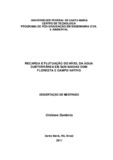| dc.creator | Dambrós, Cristiane | |
| dc.date.accessioned | 2017-02-16 | |
| dc.date.available | 2017-02-16 | |
| dc.date.issued | 2011-11-16 | |
| dc.identifier.citation | DAMBRÓS, Cristiane. RECHARGE AND FLUCTUTION LEVEL OF GROUNDWATER IN SUB-BASINS WITH FOREST AND NATIVE FIELD. 2011. 119 f. Dissertação (Mestrado em Engenharia Civil) - Universidade Federal de Santa Maria, Santa Maria, 2011. | por |
| dc.identifier.uri | http://repositorio.ufsm.br/handle/1/7773 | |
| dc.description.abstract | This study aims to contribute to the investigations aimed at understanding the behavior of
groundwater. With the aim of guiding the determination of groundwater recharge estimation and
analysis of the fluctuation of water level in relation to meteoric precipitation events. Given the research
goals relies on references: theoretical and conceptual, highlighting topics such as watershed,
groundwater level fluctuation and sustainability; methodology was applied to the quantitative method
in a systemic approach in two sub-basins, of a native field and the other with eucalyptus forest, which
is located at the outcrop zone of the Guarani Aquifer System, at rural area of the Rosário do Sul/Rio
Grande do Sul state/southern Brazil. We installed five monitoring wells and assessed the levels of
groundwater for approximately two hydrological years. A well was drilled in the sub-basin of field and
four wells in the sub-basin with forest. To estimate the recharge to one unconfined aquifer, used the
method Water Table Fluctuation WTF. Analyses of the physical characteristics of soil and rock
samples were used in detailed studies of laboratory tests related to grain size, hydraulic conductivity
and porosity. For the method WTF, needed to perform the determination of the parameters: Specific
Yield - Sy and the sum of the extrapolated values for each recession curve - ∆h. The results were
satisfactory, and the range of the fluctuation level values between 1.36 and 4.52 meters and the
estimated total groundwater recharge of precipitation in the period from 3.97% for sub-basin of the
native field and 3.20% at forested sub-basin. It is concluded that studies on the recharge of an aquifer
are critical for sustainable management of water resources at the local level (monitoring well) and
watershed scales. | eng |
| dc.description.sponsorship | Coordenação de Aperfeiçoamento de Pessoal de Nível Superior | |
| dc.format | application/pdf | por |
| dc.language | por | por |
| dc.publisher | Universidade Federal de Santa Maria | por |
| dc.rights | Acesso Aberto | por |
| dc.subject | Água subterrânea | por |
| dc.subject | Monitoramento | por |
| dc.subject | Recarga | por |
| dc.subject | Flutuação do nível | por |
| dc.subject | Método WTF | por |
| dc.subject | Subbacia hidrográfica | por |
| dc.subject | Groundwater | eng |
| dc.subject | Monitoring | eng |
| dc.subject | Recharge | eng |
| dc.subject | Fluctuation level | eng |
| dc.subject | Method WTF | eng |
| dc.subject | Sub-basin | eng |
| dc.title | Recarga e flutuação do nível da água subterrânea em subbacias com floresta e campo nativo | por |
| dc.title.alternative | Recharge and fluctution level of groundwater in sub-basins with forest and native field | eng |
| dc.type | Dissertação | por |
| dc.description.resumo | A presente pesquisa busca contribuir com as investigações voltadas ao conhecimento do
comportamento das águas subterrâneas. Com finalidade de determinar a estimativa de recarga
subterrânea e análise da flutuação do nível da água em relação a eventos de precipitação
pluviométrica. Atendendo aos objetivos a investigação se apóia nos referenciais: teórico-conceituais,
destacando-se temas como bacia hidrográfica, água subterrânea, flutuação de nível e
sustentabilidade; metodológicos, aplicou-se o método quantitativo sob uma abordagem sistêmica,
em duas sub-bacias hidrográficas, uma de campo nativo e a outra com florestamento de eucaliptos,
localizadas em zona de afloramento do Sistema Aquífero Guarani, no município de Rosário do Sul,
Rio Grande do Sul. Foram instalados cinco poços de monitoramento e avaliados os níveis da água
subterrânea por aproximadamente dois anos hidrológicos. Perfurou-se um poço na sub-bacia
hidrográfica de campo e, quatro poços na sub-bacia hidrográfica com floresta. Na estimativa de
recarga para aquíferos livres, utilizou-se pelo método Water Table Fluctuation WTF. Realizaram-se
análises das características físicas de solo e da rocha, em estudos detalhados em laboratório,
referentes a determinações de granulometria, condutividade hidráulica saturada e a porosidade total.
Para a aplicação do método WTF, necessitou-se realizar a determinação dos parâmetros:
rendimento específico Sy e do somatório dos valores do nível da água extrapolados para cada
curva de recessão - ∆h. Os resultados apresentaram-se satisfatórios, quanto à flutuação do nível
valores entre 1,36 a 4,52 metros e, à recarga subterrânea estimada do total de precipitação no
período de 3,97% para a sub-bacia hidrográfica de campo e 3,20% para a sub-bacia hidrográfica
florestada. Conclui-se que, estudos referentes à recarga de um aquífero são fundamentais para o
gerenciamento sustentável dos recursos hídricos em nível local (poço de monitoramento) ou de
bacia hidrográfica. | por |
| dc.contributor.advisor1 | Silva, Jose Luiz Silverio da | |
| dc.contributor.advisor1Lattes | http://buscatextual.cnpq.br/buscatextual/visualizacv.do?id=K4787293A4 | por |
| dc.contributor.referee1 | Werlang, Mauro Kumpfer | |
| dc.contributor.referee1Lattes | http://buscatextual.cnpq.br/buscatextual/visualizacv.do?id=K4785638D6 | por |
| dc.contributor.referee2 | Righes, Afrânio Almir | |
| dc.contributor.referee2Lattes | http://buscatextual.cnpq.br/buscatextual/visualizacv.do?id=K4787537Y9 | por |
| dc.creator.Lattes | http://buscatextual.cnpq.br/buscatextual/visualizacv.do?id=K4238209J2 | por |
| dc.publisher.country | BR | por |
| dc.publisher.department | Engenharia Civil | por |
| dc.publisher.initials | UFSM | por |
| dc.publisher.program | Programa de Pós-Graduação em Engenharia Civil | por |
| dc.subject.cnpq | CNPQ::ENGENHARIAS::ENGENHARIA CIVIL | por |


